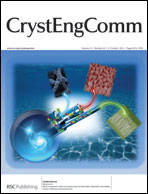Three new organic–inorganic hybrid compounds based on copper-bis(triazole) complexes and Keggin-type polyoxometalates (POMs) with different negative charges, [Cu(I)BBTZ]3[PMo12O40] (1), [Cu(I)BBTZ][Cu(I)(HBBTZ)2][SiMo12O40]·2.5H2O (2) and [Cu(I)BBTZ]6[SiWV2WVI10O40]·2H2O (3) (BBTZ = 1,4-bis(1,2,4-triazol-1-ylmethyl)benzene), have been hydrothermally prepared and characterized by elemental analyses, IR spectra, TG analyses, XPS spectra, powder X-ray diffraction and single-crystal X-ray diffraction analyses. Compounds 1 and 2 exhibit the POM-templated 3D host–guest supramolecular frameworks. Compound 3 displays a POM-supported 3D open framework. In these three hybrid compounds, the structural transformation from host–guest framework to open framework were modulated by the introduction of Keggin-type polyoxoanions with different negative charges. Moreover, the electrochemical properties of compounds 1–3 were investigated and all these compounds show the electrocatalytic activities towards the reduction of nitrite.

You have access to this article
 Please wait while we load your content...
Something went wrong. Try again?
Please wait while we load your content...
Something went wrong. Try again?


 Please wait while we load your content...
Please wait while we load your content...